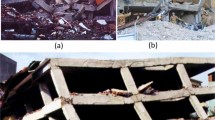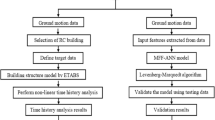Abstract
Artificial neural networks, ANNs, can predict the behavior of systems that have common main features. When the problem under consideration contains groups that involve different main features, different ANNs are needed to predict the behavior of each group separately. In this paper, the efficiency of a single ANN to predict the lateral behavior of two-span structures representing a mix of low-, medium- and high-rise buildings in Egypt was investigated. All buildings were first analyzed using nonlinear pushover analysis to obtain their capacity curves, failure loads and displacements. Obtained data were used for training different ANN models. The results indicated the efficiency of a single ANN to predict the behavior of a mix of all buildings under investigation with a confidence level of 99%. The successful network was further utilized to obtain another set of data that were merged with the original data and used to develop a design neural network. The obtained network showed a very good capability to predict design variables which can be a good tool for engineering practitioners.
Similar content being viewed by others
Abbreviations
- ANNs:
-
Artificial neural networks
- FEM:
-
Finite element method
- RC:
-
Reinforced concrete
- MSE:
-
Mean square error
- GFF:
-
Generalized feedforward network
- GR:
-
General recurrent network
- MP:
-
Multilayer perceptron network
- PCA:
-
Principal component analysis network
- M:
-
Momentum learning functions.
- Q:
-
Quick-propagation learning functions.
- CG:
-
Conjugate gradient learning functions.
- \({t}_{\mathrm{w}}\) :
-
Thickness of masonry walls
- \({E}_{\mathrm{s}}\) :
-
Steel modulus of elasticity
- \({F}_{\mathrm{cu}}\) :
-
Compressive strength of concrete
- \({F}_{\mathrm{tu}}\) :
-
Ultimate tensile strength of steel
- \({\upupsilon }\) :
-
Poisson’s ratio
- \({f}_{\mathrm{sy}}\) :
-
Yield strength of steel
- (B.S/T.W):
-
Base shear over total weight
- (T.D/T.H).:
-
Top displacement over total height
- f(t):
-
Transfer function
- SX:
-
The normalized value
- \(R^{2}\) :
-
Coefficient of multiple determinations
- L-ANN:
-
ANN for low-rise buildings
- H-ANN:
-
ANN for high-rise buildings
- M-ANN:
-
ANN for a mix of low- and high-rise buildings
- D-ANN:
-
ANN for design of low- and high-rise buildings
References
Inel, M.; Bilgin, H.; Ozmen, H.B.: Seismic capacity evaluation of school buildings in Turkey. In: Proceedings of Institution of Civil Engineers, Structures & Buildings, vol. 161(SB3), pp. 147–159 (2008a)
Inel, M.; Ozmen, H.B.; Bilgin, H.: Re-evaluation of building damage during recent earthquakes in Turkey. Eng. Struct. 30, 412–427 (2008b)
Inel, M.; Ozmen, H.B.; Bilgin, H.: Seismic performance evaluation of school buildings in Turkey. Struct. Eng. Mech. 30(5), 535–558 (2008c)
Yakut, A.; Tonguc, Y.; Gulkan, P.: A comparative seismic performance assessment and rehabilitation of existing school buildings. In: 14th World Conference on Earthquake Engineering, Oct 12–17, Beijing, China (Paper No: 14_09-01-0143) (2008)
Kaltakci, M.; Arslan, M.; Yilmaz, S.; Arslan, H.: A new approach on the strengthening of primary school buildings in Turkey: an application of external shear wall. Build. Environ. 43, 983–990 (2008)
Kaltakci, M.; Ozturk, M.; Arslan, M.H.: An experimental investigation for external RC shear wall applications. Natural Hazards Earth Syst. Sci. 10(9), 1941–1950 (2010)
Oyguc, R.: Seismic performance of RC school buildings after 2011 Van earthquakes. Bull. Earthq. Eng. https://doi.org/10.1007/s10518-015-9857-4 (2015).
Nicola, T.; Leandro, C.; Guido, C.; Enrico, S.: Masonry infilled frame structures: state-of-the-art review of numerical modelling. Earthq. Struct. (2015). https://doi.org/10.12989/eas.2015.8.3.733
Seleemah, A.A.: Inelastic seismic behavior of masonry infilled reinforced concrete structures. In: 10th International Colloquium on Structural and Geotechnical Engineering, Ain Shams University, April (2003)
Amanat, K.M.; Hoque, E.: A rationale for determining the natural period of RC building frames having infill. Eng. Struct. 28, 495–502 (2006)
Anil, O.; Altin, S.: An experimental study on reinforced concrete partially infilled frames. Eng. Struct. 29, 449–460 (2007)
Kadysiewski, S.; Mosalam, K. M.: Modeling of unreinforced masonry infill walls considering in-plane and out-of-plane interaction. Report PEER 2008/102, Jan (2009)
Tan, K.; Abdul, R.H.; Lu, D.; Li, Y.: Seismic response of a four-storey RC school building with masonry-infilled walls. Nat. Hazards 78, 141–153 (2015)
Campione, G.; Cavaleri, L.; Macaluso, G.; Amato, G.; Di Trapani, F.: Evaluation of infilled frames: an updated in-plane-stiffness macro-model considering the effects of vertical loads. Earthq. Eng. Bull. 13, 2265–2281 (2015). https://doi.org/10.1007/s10518-014-9714-x
Furtado, A.; Rodrigues, H.; Arêde, A.; Varum, H.: Simplified macro-model for infill masonry walls considering the out-of-plane behaviour. Earthq. Eng. Struct. Dyn. 45, 507–524 (2016)
Milheiro, J.; Rodrigues, H.; Arêde, A.: Evaluation of the contribution of masonry infill panels on the seismic behaviour of two existing reinforced concrete buildings. KSCE. J. Civ. Eng. (2015). https://doi.org/10.1007/s12205-015-0112-y
Bakhary, N.; Hao, H.; Deeks, A.J.: Damage detection using artificial neural network with consideration of uncertainties. Eng. Struct. 29, 2806–2815 (2007)
Arslan, M.H.: Application of ANN to evaluate effective parameters affecting failure load and displacement of RC buildings. Natural Hazards Earth Syst. Sci. 9, 967–977 (2009)
Turkish Earthquake Code (TEC): Regulations on Structures Constructed in Disaster Regions. Ministry of Public Works And Settlement, Ankara (2006)
Arslan, M.H.: An evaluation of effective design parameters on earthquake performance of RC buildings using neural networks. Eng. Struct. 32, 1888–1898 (2010)
Nikoo, M.; Zarfam, P.; Nikoo, M.: Determining displacement in concrete reinforcement building using evolutionary artificial neural networks. World Appl. Sci. J. 12, 1699–1708 (2012)
Lagaros, N.D.; Papadrakakis, M.: Neural network based prediction schemes of the non-linear seismic response of 3D buildings. J. Adv. Eng. Softw. 44, 92–115 (2012)
Sipos, T.K.; Sigmund, V.; Marijana, H.: Earthquake performance of infilled frames using neural networks and experimental database. Eng. Struct. 51, 113–127 (2013)
Abou El-Ftooh, K.A.; Seleemah, A.; Atta, A.M.; Taher, S.E.F.: Damage mechanics based model for low-rise infilled RC frames incorporating neural networks. Eng. Comput. 33(4), 1114–1140 (2016)
Emporis, Standards: Data Standards: Structures. Data Company, Hamburg (2009). (retrieved Oct 2015 )
Uniform Building Code (UBC): International Conference of Building Officials, Whittier (2006)
Akberuddin, M.A.; Saleemuddin, M.Z.: Pushover analysis of medium rise multi-story RCC frame with and without vertical irregularity. Int. J. Eng. Res. Appl. 3(5), 540–546 (2013)
Naguib, M.; Salem, F.A.; El-Bayoumi, K.: Dynamic analysis of high rise seismically isolated buildings. Am. J. Civ. Eng. 3(2), 43–50 (2015)
Plevris, V.; Asteris, P.G.: Modeling of masonry failure surface under biaxial compressive stress using neural networks. Constr. Build. Mater. 55, 447–461 (2014)
Abou El-Ftooh, K.A.; Sharkawi, A.E.M.; Taher, S.E.F.: Nonlinearity of coupled R.C. system with infill stiffening. Sci. Bull. Fac. Eng. 42(3), 15–32 (2007)
Afefy, H.M.; Taher, S.E.F.; Khalil, A.A.; Issa, M.E.: Nonlinear response of reinforced concrete infilled frames under lateral dynamic excitations. J. Eng. Appl. Sci. 48(6), 139–1163 (2001)
Afefy, H.M.; Taher, S.F.; Khalil, A.A.; Issa, M.E.: Statistically equivalent nonlinear finite element model for infilled R.C. framed systems. Eng. Comput. 19(2), 190–206 (2002)
Afefy, H.M.; Taher, S.F.; Khalil, A.A.; Issa, M.E.: Damage evolution and frequency attenuation of reinforced concrete infilled frames. Sci. Bull. Fac. Eng. 39(2), 13–29 (2004)
Moubarak, A.M.R.; Taher, S.E.F.: Enhanced behavior of wall panels by various reinforcing patterns. Sci. Bull. 42(3), 30 (2007)
Moubarak, A.M.R.; Taher, S.E.F.: Iterative analytical model for the composite behavior of wall-panels in reinforced high strength concrete skeletons. J. Al-Azhar Univ. 2(5) (2007)
Moubarak, A.M.R.; Taher, S.E.F.: Load sharing of masonry panels within reinforced high strength concrete systems. Hous. Build. Natl. Res. Cent. J. 3(3) (2007)
Moubarak, A.M.R.; Taher, S.E.F.: Effect of reinforcing patterns on the behavior of masonry walls in R.C. frames. Arab. J. Sci. Eng. 34(2B) (2009)
Urban Dictionary: Urbandictionary.com Site Info. Alexa Internet. Retrieved Oct 2015 (2014)
National Fire Protection Association (NFPA): How Codes and Standards are Developed?. www.nfpa.com (2014). Retrieved Oct 2015
Abou El-Ftooh, K. A.: Analysis of reinforced concrete frames using artificial neural networks, p. 286. Ph.D. Dissertation in Civil Engineering, Faculty of Engineering, Tanta University (2015)
Taher, S.F.; Baluch, M.H.: Theory of dichotomy for biaxial elastoplastic damage modeling of concrete. J. Damage Mech. 6(2), 166–194 (1997)
Taher, S.F.; Baluch, M.H.: Rational split of strain tensor in elastoplastic damage mechanics. J. Strain Anal. 37(2), 117–124 (2002)
Taher, S.F.; Baluch, M.; Al-Gadhib, A.: Towards a canonical elastoplastic damage model. J. Eng. Fract. Mech. 48(2), 151–166 (1994)
ANSYS Version 15: User’s and Theory Reference Manual (2013)
William, K.J.; Warnke, E.D.: Constitutive model for the triaxial behavior of concrete. In: Proceeding International Association for Bridge and Structural Engineering, vol. 19, p. 174 (1975)
NeuroSolutions Version 5.07: User’s and Theory Reference Manual (2005)
Author information
Authors and Affiliations
Corresponding author
Rights and permissions
About this article
Cite this article
El-Ftooh, K.A., Seleemah, A.A., Atta, A.A. et al. Does a Single ANN Properly Predict Pushover Response Parameters of Low-, Medium- and High-Rise Infilled RC Frames?. Arab J Sci Eng 43, 5517–5539 (2018). https://doi.org/10.1007/s13369-018-3195-1
Received:
Accepted:
Published:
Issue Date:
DOI: https://doi.org/10.1007/s13369-018-3195-1




